Art Education in Schools
The arts community welcomed the final endorsement of the National Curriculum: The Arts by the Education Council after a long campaign by arts advocates in 2015. The revised Australian Curriculum will be rolled out in 2022.
The arts community welcomed the final endorsement of the National Curriculum: The Arts by the Education Council after a long campaign by arts advocates in 2015. The revised Australian Curriculum will be rolled out in 2022.

In 2021, the Australian Curriculum, Assessment and Reporting Authority’s (ACARA) opened the revised draft of the Australian Curriculum K-10 for public consultation until 8 July. NAVA took a leading role in coordinating a visual arts, craft and design response to the review.
With the support of April Phillips, Wiradjuri-Scottish visual artist, researcher and digital arts educator at Big hART, NAVA engaged the Art Gallery of South Australia’s Neo Ambassadors, a committee of young people aged 13 to 17 living in South Australia.
NAVA hosted an open Curriculum Consultation via Zoom for the visual arts and craft sector to discuss the changes, push for improvements and strategise on what’s needed to support teachers to deliver this ambitious framework. We were heartened by the level of enthusiasm, engagement and expertise of everyone who participated and thank everyone for their valuable contributions.
NAVA prepared a submission and summary of strengths and opportunities raised through NAVA’s consultations.
Inquiry into school to work transition
In May 2017 the Federal Government led by the Minister for Employment, Education and Training, Senator the Hon Simon Birmingham set up an Inquiry on how students are supported from school to work.
According to the Parliamentary website: “The inquiry will look at ways to ensure students are supported from school to work by measuring gain in schools and how this contributes to supporting students for post-school education and training. The inquiry will also look at opportunities to better inform students of appropriate post-school education and training using employment outcomes as a measure of course suitability.” You can read more about this Inquiry here.
NAVA has made a submission to this inquiry available here.
The new arts curriculum was finally endorsed. As part of the national curriculum for all Australian schools. The
Australian Curriculum: The Arts provides a rationale and specifies curriculum
content from Foundation to Year 10 for five artforms: Dance, Drama, Media Arts,
Music and Visual Arts.
To check it out go here.
In partnership with the National Advocates for Arts Education (NAAE), NAVA campaigned vigorously for this new visual arts curriculum and advised at every stage of its development. Finally it has been approved for roll out as part of the entitlement of students in all states and territories to a coherent high quality arts education.
With the change of government, the previous Education Minister, Christopher Pyne commissioned a review of the whole national curriculum. On Sunday 12 October 2014, the Review of the Australian Curriculum – Final Report was released. While the report stresses the importance of arts education and the need to support professional development of teachers, it had suggested that "two of the arts strands should be mandatory and we recommend music and visual arts. The other three strands would be elective subjects and schools would choose which to offer..."
Fortunately this has not been followed through.
To read the arts section of the Review Report go here. To read the whole report go here.
The review recommendations were opposed by all the peak arts and education body members of the NAAE in a broadly distributed open submission. We called for the curriculum to be approved and applied in its current form. To read go here.
To read the media release by the NAAE welcoming the final endorsement of The Australian Curriculum: The Arts go here.
Tamara Winikoff presented a talk via Skype at the art education research symposium QUT Tier 4 AARE Arts Symposium. View online here.

Infographics by T. Andrew, 2014.
Statistical references 1 - 5.
2003 NAVA formed the Visual Education Roundtable to advocate
2004 National Review of Visual Education commissioned by Government
2008
2011 The Shape of the Australian Curriculum: the Arts published
2012 Draft Australian Curriculum: The Arts Foundation to Year 10 was open for public consultation until 23 September 2014
2014 Australian Curriculum: The Arts published on-line awaiting Government endorsement
2015 Australian Curriculum: The Arts endorsed by the Education Council
Back in 2003 NAVA began advocating for a study to be done on the state of visual education in schools. NAVA formed the Visual Education Roundtable with representatives from across the sector including primary and secondary teachers and school principals, universities and TAFEs, parent associations, gallery education staff, public and private galleries and art supplies retailers. The Roundtable jointly lobbied to achieve government support for a National Review of Visual Education (NRVE).
NAVA argued that the rapid development of the use of visual modes of communication (digital cameras, tablets, computers etc), means that visual education has become as essential for all C21st children as training in literacy and numeracy.
Eventually the Commonwealth Government pledged its support and commissioned some research - the National Review of Visual Education.
From 2005 – 2007, NAVA served on the Steering Committee for this Review co-funded by the Australia Council and the then Australian Government Department of Education, Science and Training (DEST) through its research program.
The resulting report 'First We See: The National Review of Visual Education' was published in 2008. It made four major recommendations in relation to visual education which provided the blueprint for subsequent negotiation.
Using the findings of this report, NAVA conducted a vigorous advocacy campaign for visual education lobbying for the mandating of visual education in all schools around the country. The newly elected Labor Government made a commitment to a national curriculum for schools and in 2008 NAVA joined with other peak artform bodies and teacher organisations in the four other arts disciplines (drama, dance, media and music) to form the National Advocates for Arts Education (NAAE).
The NAAE lobbied tirelessly and acted as expert adviser to the body appointed in 2008 by the government, the Australian Curriculum Assessment and Reporting Authority (ACARA) with responsibility for the development of the Australian Curriculum. NAAE's efforts resulted in agreement by the Government to include the arts in Phase 2 of the curriculum development process.
In 2008 the Melbourne Declaration on Educational Goals for Young Australians was agreed to by all Australian education ministers. It committed to supporting "all young Australians to become successful learners, confident and creative individuals, and active and informed citizens". This document provided the scope for the development of the Australian Curriculum.
ACARA commissioned a small group of arts education specialists to advise on the first stage of the process. Art education academic Elizabeth Grierson provided specialist visual arts, craft and design input, working with the lead writer, Professor John O'Toole and other art form advisers to produce an initial 'advice paper'. Feedback was sought from parents, educators, and the community on what young people should learn in the subjects of Dance, Drama, Media Arts, Music and Visual Arts.
The ideas were presented to a large national forum with experts from the full range of arts disciplines, as well as industry experts, teachers, professional associations and education authorities.
In May 2010, Tamara Winikoff NAVA's Executive Director presented a paper at UNESCO's Second World Conference on Arts Education.
After extensive consultation a contextual document was published in August 2011, The Shape of the Australian Curriculum: the Arts
What followed was more than three years of further development to produce an agreed national curriculum for the arts. Members of the NAAE played a key role providing expert advice and acting as intermediary between their constituents and ACARA.
The draft Australian Curriculum: The Arts Foundation to Year 10 was open for public consultation until 23 September 2012. NAVA made a submission in support of the case put by the Visual Arts and Design Educators Association NSW (VADEA) for better drafting of the visual arts component.
In February 2014, NAAE warmly welcomed the on-line publication of the Australian Curriculum: The Arts which awaited final endorsement.
This endorsement was finalised in October 2015.